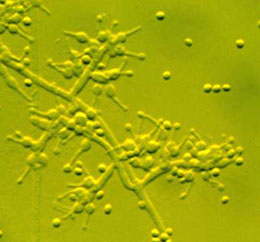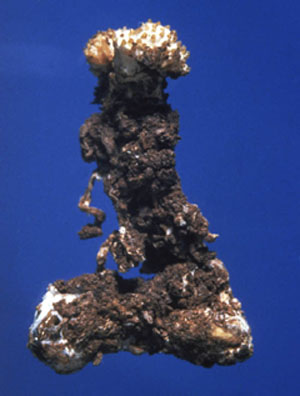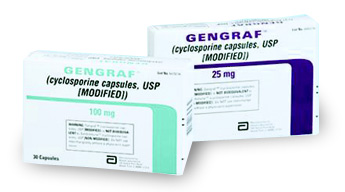It is spring/summer here in Wisconsin and typically June's fungus of the month is a mushroom that we find this
time of year. This month is something quite different and relates not to the month of June, but rather to Tom himself (Keep reading).
This month's fungus is Cordyceps subsessilis, a bafflingly rare fungus that's a pathogen of scarab beetles.
I'd be pretty surprised if you ever encounter it. Students in a class I was teaching did once, and there was a
big to-do about it, and a level
of media
attention few fungi ever receive.
If you ever did find it, you'd notice the deceased beetle grub at the bottom, and the weird malformed stalk
leading to a small crown of yellow fruiting bodies (perithecia). I admit, it's an ugly thing, and rare too. On the
other hand, the asexual state of C. subsessilis is a lovely, white mold called
Tolypocladium inflatum. It's quite common in soil, and I once found it in the foam beneath a local
waterfall. Not only is T. inflatum a charming little thing, with demurely bent necks and dainty jellydrops
of spores (below, right), but it is one of those celebrity fungi, famous the world over for its useful chemical talents.
Tolypocladium inflatum is rich and famous because it produces cyclosporin, an immunosuppressant
drug used following organ transplantation. It prevents the body from rejecting foreign tissues, like the
new heart that our friend Tom Volk received last month
(yes, really) On Monday May 22, 2006 Tom was fortunate enough to receive a 'certified pre-owned heart'. He is doing great
and you can read about Tom's health update here.
Cyclosporin is a small circular peptide (view it in 3-D
here). It acts to suppress the production of certain
types of white blood cells (T-helper cells and T-suppressor cells), and prevents expression of interleukins,
all of which are involved in the body's ability to recognize and defend against foreign
 cells. Cyclosporin revolutionized transplant therapy after it was discovered in the 1970s, but it has some
negative effects too. It's hard on the kidneys, may cause nervous system issues, and promotes buildup of harmful
lipids like cholesterol in the vascular system. Ironically, another Cordyceps species used in Chinese
medicine, C. sinensis,
may counteract some of cyclosporin's negative effects (Xu et al. 1995).
cells. Cyclosporin revolutionized transplant therapy after it was discovered in the 1970s, but it has some
negative effects too. It's hard on the kidneys, may cause nervous system issues, and promotes buildup of harmful
lipids like cholesterol in the vascular system. Ironically, another Cordyceps species used in Chinese
medicine, C. sinensis,
may counteract some of cyclosporin's negative effects (Xu et al. 1995).
 Cyclosporin isn't the only immunosuppressant derived from a fungus. A new one, FTY720, was derived from the closely
related fungus shown at left. Isaria sinclairii kills cicada nymphs and makes little yellowish stalks topped
with kazillions of powdery spores. Those spores go on to kill more cicadas. Thank goodness these things don't attack
people. Spores that land on the surface of a suceptible insect just germinate and grow right through that tough bug
exoskeleton. Once inside, they just keeping growing until they've devoured the bug from the inside. Unlike
T. inflatum, which had no claim to fame before cyclosporin was discovered, Isaria sinclairii has
been used medicinally for hundreds of years in China.
Cyclosporin isn't the only immunosuppressant derived from a fungus. A new one, FTY720, was derived from the closely
related fungus shown at left. Isaria sinclairii kills cicada nymphs and makes little yellowish stalks topped
with kazillions of powdery spores. Those spores go on to kill more cicadas. Thank goodness these things don't attack
people. Spores that land on the surface of a suceptible insect just germinate and grow right through that tough bug
exoskeleton. Once inside, they just keeping growing until they've devoured the bug from the inside. Unlike
T. inflatum, which had no claim to fame before cyclosporin was discovered, Isaria sinclairii has
been used medicinally for hundreds of years in China.
Nobody knows why a fungus should produce such a useful molecule as cyclosporin or FTY720.
Every fungus needs a chemical arsenal, perhaps in this case to overcome the primitive immune defenses of
bugs...but maybe not.
Further reading on Chinese medicines and immunosuppressant drugs: http://home.pusan.ac.kr/~imds/Chinese_GPCR.pdf
This month's guest writer is Kathie Hodge, who wishes Tom well.
We know you do, too. Again, you can read about Tom's health here.


